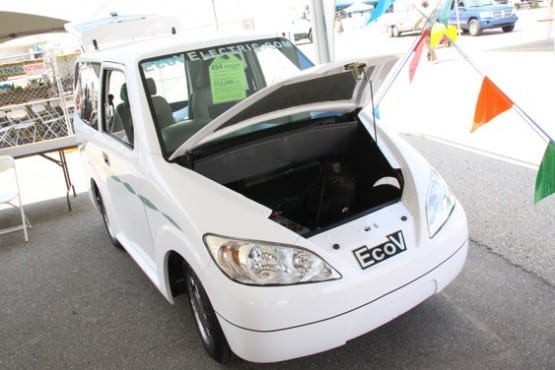In what may be a prelude of the future urban market, a Detroit-based manufacturer named EcoV Electric is offering an electric vehicle for just under $12,000.
The EcoV is geared towards urban driving — lower speed commutes over relatively short distances — and can go 25 to 40 miles on a charge. It charges by plugging into a standard wall socket and the company pegs the cost of the electricity for a recharge at a mere 50 cents. Thanks to those reduced fuel and maintenance costs, and the $11,999 price tag, they also estimate the car should pay for itself within a year. Safety-wise the EcoV is built with a roll cage frame, and the lack of a large gasoline-powered engine block actually makes electric cars safer in head-on collisions in general.
Obviously, these features also come with limitations most American car customers aren’t used to. The key is realizing they’re well-geared towards two specific emerging markets.
One is urban commuters: people who live in denser areas and use their cars for short trips to work or the grocery store, while relying on rented cars, air travel, or public transportation for longer trips. Traffic congestion resulted in an estimated 56 billion pounds of carbon pollution in 2012, so turning all that commuting over to electric power could come with climate benefits. Furthermore, demonstration projectsare already showing how digital technology and the smart grid can be used by individuals to control when and how their electric vehicles are charged, which cuts down on their electricity bills.
The other market is delivery businesses that rely on urban fleets. Again, it’s a job well-suited to vehicles with the EcoV’s characteristics: the daily routes and range needs are known and fixed, and the vehicles return to the same spot every night which makes re-charging much easier. EcoV seems to realize its potential in this area, as it’s designed the car to come in several iterations, including four-passenger vehicles, six-passenger vehicles, pickup trucks, delivery trucks, and more.
Fleets of small electric vehicles for urban driving are also possible investments for cab companies and other car-sharing arrangements, which again can cut down on the need for car ownership amongst dense populations and also cut carbon emissions. Further in the future, there’s also the possibility of combining those electric vehicles with something like Google’s driverless car technology and Uber’s smartphone-based cab-hailing service, as Matt Yglesias recently described.
As CleanTechnica explains, EcoV’s use of a low-capital-intensive business model — the reverse of what you usually see in auto-manufacturing — is what enabled the company hit such a low price tag. “A capital-intensive business model involves purchasing factory machinery with a high initial cost, and these machines have to pay for themselves for them to make financial sense.” Further, “a high production volume is required for them to pay for themselves, and electric vehicle production volume (in general) is currently low, making it more difficult for factory machinery to pay for itself.”
Being Detroit-based, EcoV also shows one potential strategy U.S. automakers specifically could use to keep building on their recovery by moving even further into the expanding electric vehicle market.
Source: Climate Progress. Reproduced with permission.










